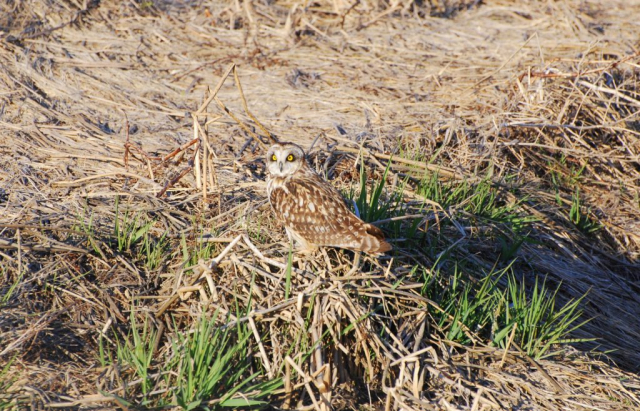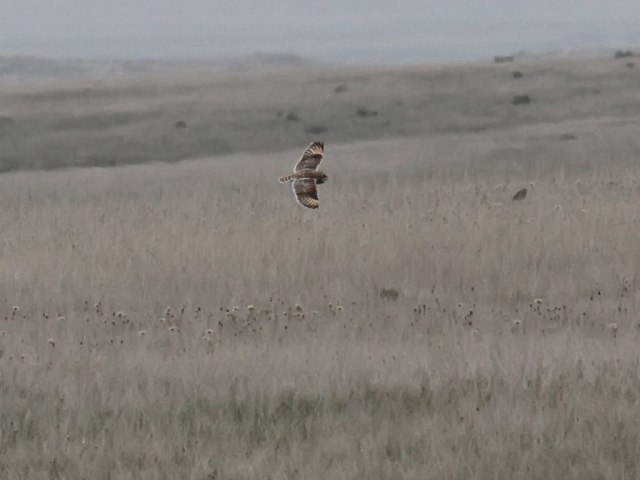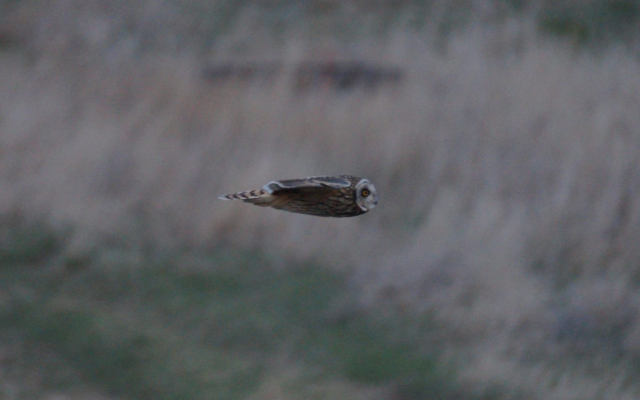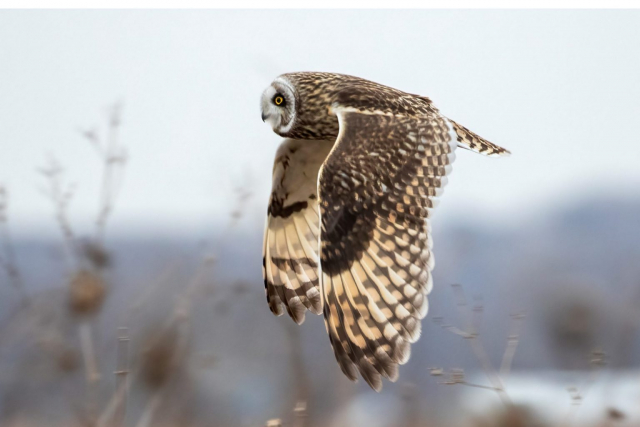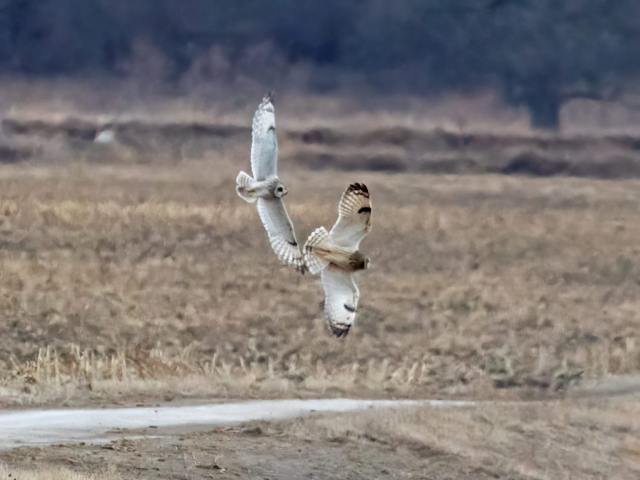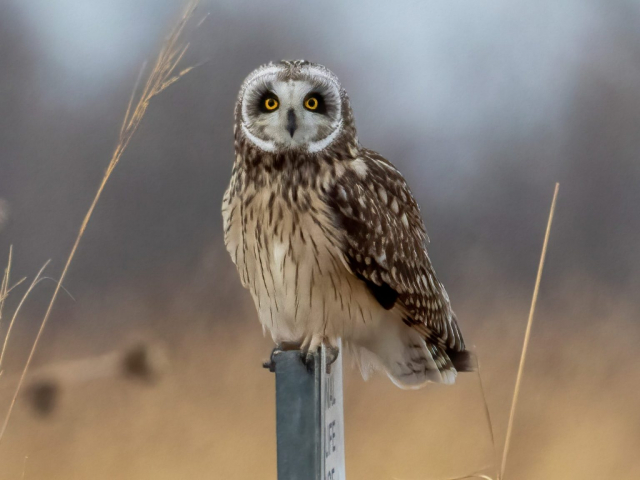Asio flammeus flammeus
Status: Rare regular resident north and west. Uncommon regular winter visitor statewide.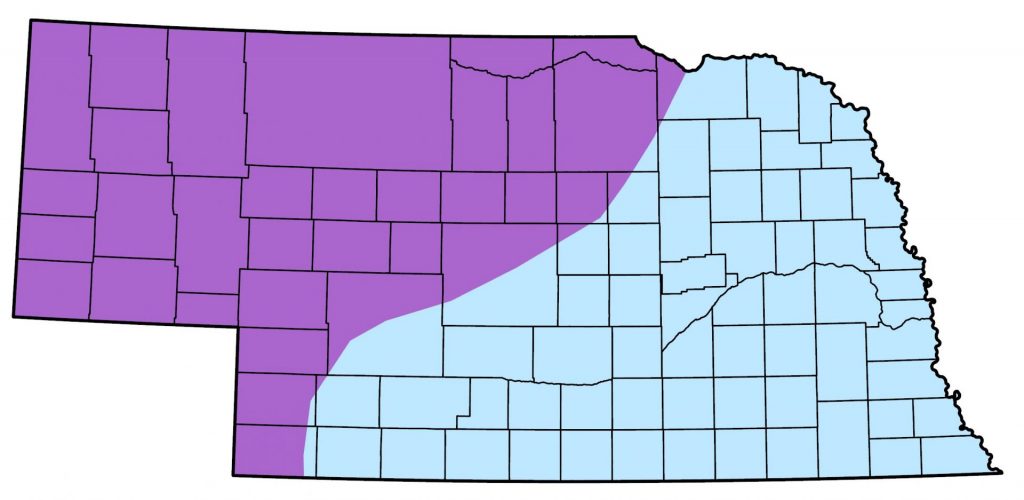
Documentation: Specimen: UNSM ZM7740, 4 Dec 1902 Kirkwood, Lancaster Co.
Taxonomy: There are 11 subspecies currently recognized, only one, flammeus, occurring in North America, the other 10 subspecies are distributed worldwide except for Australia; several are island endemics (AviList 2025).
Nebraska birds are flammeus.
Resident: Currently (2023) Short-eared Owl appears to be a rare nester in Nebraska, although its summer status is poorly known (Ducey 1988, Mollhoff 2001). Breeding populations fluctuate widely depending on rodent populations, and breeding may be colonial at times and non-existent at others. Most authors consider this species to have declined significantly in Nebraska this century, at least partly due to habitat loss (Blake and Ducey 1991, Brogie and Mossman 1983, Ducey 1988).
There are only these few reports of nesting since 1960, all in the north and west: a nest was photographed in Brown Co in the late 1960s (Mossman and Brogie 1983); another was found by S. R. Young in a dryland wheat field in Banner Co in 1966 (Sharpe 1967); a nest card was submitted for Hall Co in 1967 (Bennett 1968); two nests were reported in Garden Co in 1967, one with eggs 2 Jun the other with young 8 Jun (Wilbrecht, Gunderson, in Mollhoff 2022; Bennett 1968); young were noted in Holt Co in 1973 (Bennett 1974); a nest with eggs and young were at Valentine NWR, Cherry Co 9 May 1988 (McDaniel; Mollhoff 2022); a successful nest in a Perkins Co stubble field was reported 23 Jul 2008 (T.J. Walker, personal communication); an adult was feeding a begging young bird at Agate Fossil Beds NM, Sioux Co 5 Jun 2016; and adults with four new fledglings were found and photographed along Highway 385 a few miles northwest of Chadron, Dawes Co 28 Jun 2020 (Goldthwaite, Kibbe; eBird.org). A strong distraction display was reported 28 Jun 2024 along CR X, Scotts Bluff Co.
Good numbers were reported in summer 2024, presumably due to high rainfall in 2023 and probably subsequent good populations of voles (Shaun Dunn fide Joel Jorgensen, personal communication). Best counts reported in 2024 likely involved one or more family groups, such as the 16 on 27 Jul about 25 miles north of Scottsbluff in Sioux Co on an ungrazed pasture; these birds disappeared when cattle were put into the pasture in late summer (Rex Morse, personal communication).
There are numerous reports May-Sep without evidence of nesting; most are associated with native grasslands, including those in the southeast. Three sightings at the northeastern corner of Calamus Reservoir, Loup Co 20 Apr-29 May 2019 may have been of locally breeding birds, and there were three reports 10 Jun-8 Jul 2020 at potential breeding locations in the northern Panhandle.
Egg dates are in Apr and May (Bent 1938, Wiggins et al 2020) or into Jun (Mollhoff 2022); reports at that time are suggestive of nesting, although the species may be present but not nesting if rodent populations are low.
- Breeding Phenology:
- Distraction display: 28 Jun
- Eggs: 7 May- 15 Jun (Mollhoff 2022)
- Nestlings: 9 May- 8 Jun (Mollhoff 2022)
- Fledglings: 5-28 Jun
Winter: Oct 15, 15, 15 <<<>>> Apr 24, 24, 25
Earlier dates in the south and east are 3 Sep 2009 Lincoln Co and 14 Sep 2012 Hayes Co.
Later dates in the south and east are 27 Apr 2015 Lincoln Co, 29 Apr 2021 Wayne Co, and 20 May 2008 Lincoln Co.
While evidence is scarce, Nebraska birds likely remain on their summer ranges during winter if weather and food conditions allow (Rosche 1982). This species could be considered nomadic rather than migratory, often appearing in numbers wherever the rodent population is high. However, in most years, there is a consistent increase in numbers mid-Oct through late Apr; banding studies suggest north-south migration, especially from northern parts of the range (Wiggins et al 2020). Two Short-eared Owls fitted with transmitters in southwestern Wyoming in summer 2020 moved in opposite directions, one moving eastward about 600 miles to the Lodgepole Creek area in southwestern Nebraska and in extreme northeastern Colorado during fall and early winter 2020-2021 (https://www.boisestate.edu/). Multiple Short-eared Owls outfitted with satellite transmitters on the Seward Peninsula in Alaska migrated in fall through the Great Plains and as far south as northern Mexico (Johnson et al 2017).
Wintering birds occur statewide, generally south of the snowline, where their rodent diet remains available. Reports are fewest in Feb. Numbers vary considerably from winter to winter depending on snow cover, and the species may be absent in some winters. At least 30 were reported during winter 2011-2012, when snow cover was minimal in Nebraska, all but five from the eastern half of the state. An even better year was 2021-2022, when about 44 were reported statewide. One observer (Shari Schwartz, personal communication) suggested that the good numbers of Snowy Owls and Short-eared Owls in winter 2021-2022 may not be unexpected since breeding ranges of both owls overlap and both prey on lemmings. Winter 2022-2023 had good numbers as well, some 37 reported statewide, although only one Snowy Owl was found. Winter 2024-2025 had an amazing total of 69 statewide, suggesting an abundant and available food supply.
- High counts: 17 at Lake McConaughy, Keith Co 27 Dec 2006, 12 at Jack Sinn WMA, Lancaster Co 21 Nov 2006, and 11 at Lake McConaughy 25 Feb 2006.
Images
Abbreviations
NM: National Monument
NWR: National Wildlife Refuge’
UNSM: University of Nebraska State Museum
WMA: Wildlife Management Area (State)
Literature Cited
AviList Core Team, 2025. AviList: The Global Avian Checklist, v2025. https://doi.org/10.2173/avilist.v2025.
Bennett, E.V. 1968. 1967 Nebraska nesting survey. NBR 36: 35-42.
Bennett, E.V. 1974. 1973 Nebraska nesting survey. NBR 42: 3-10.
Bent, A.C. 1938. Life histories of North American birds of prey. Part Two. Bulletin of the United States National Museum 170. Dover Publications Reprint 1961, New York, New York.
Blake, L., and J. E. Ducey. 1991. Birds of the eastern Sandhills in Holt County, Nebraska. NBR 59: 103-132.
Brogie, M.A., and M.J. Mossman. 1983. Spring and summer birds of the Niobrara Valley Preserve, Nebraska: An annotated checklist. NBR 51: 44-51.
Ducey, J.E. 1988. Nebraska birds, breeding status and distribution. Simmons-Boardman Books, Omaha, Nebraska, USA.
Johnson, J. A., T.L. Booms, L.H. DeCicco, and D.C. Douglas. 2017. Seasonal movements of the Short-eared Owl (Asio flammeus) in western North America as revealed by satellite telemetry. Journal of Raptor Research 51: 115-128.
Mollhoff, W.J. 2001. 1999-2000 Nebraska nesting report. NBR 69: 92-101.
Mollhoff, W.J. 2022. Nest records of Nebraska birds. Nebraska Ornithologists’ Union Occasional Paper Number 9.
Mossman, M.J., and M.A. Brogie. 1983. Breeding status of selected bird species on the Niobrara Valley Preserve, Nebraska. NBR 51: 52-62.
Rosche, R.C. 1982. Birds of northwestern Nebraska and southwestern South Dakota, an annotated checklist. Cottonwood Press, Crawford, Nebraska, USA.
Sharpe, R.S, 1967. The 1966 nesting season. NBR 35: 29-38.
Wiggins, D.A., D.W. Holt, and S.M. Leasure. 2020. Short-eared Owl (Asio flammeus), version 1.0. In Birds of the World (S. M. Billerman, Editor). Cornell Lab of Ornithology, Ithaca, NY, USA. https://doi.org/10.2173/bow.sheowl.01.
Recommended Citation
Silcock, W.R., and J.G. Jorgensen. 2025. Short-eared Owl (Asio flammeus flammeus). In Birds of Nebraska — Online. www.BirdsofNebraska.org
Birds of Nebraska – Online
Updated 14 Jul 2025, Map updated 17 Jun 2025
